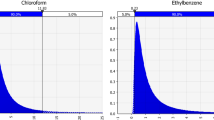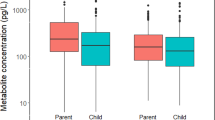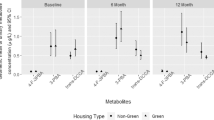Abstract
As part of the Minnesota Children's Pesticide Exposure Study we measured volatile organic compound (VOC) concentrations in a probability sample of households with children. The 6-day average concentrations for 10 common VOCs were obtained in urban and nonurban residences twice during this multiphase study: screening-phase indoor measurements were collected in 284 households, and in the intensive-phase matched outdoor (O), indoor (I), and personal (P) measurements were collected in a subset (N=72) of the screened households. Screening-phase households with smokers had significantly higher concentrations of benzene and styrene compared to nonsmoking households; households with an attached garage had significantly higher levels of benzene, chloroform, styrene, and m/p- and o-xylene compared to households without an attached garage; and nonurban residences, which had a greater prevalence of smokers and attached garages, had significantly higher 1,1,1-trichloroethane, styrene, and toluene and significantly lower tetrachloroethylene concentrations compared to urban households. The screening-phase weighted distributions estimate the mean and variability in indoor VOC concentrations for more than 45,000 households with children in the census tracts sampled. Overall, median indoor concentrations of most VOCs measured in this study were similar to or lower than indoor levels measured previously in the United States. Intensive-phase outdoor VOC concentrations were generally lower than other major metropolitan areas, but urban concentrations were significantly higher than nonurban concentrations for all compounds except 1,1,1-trichloroethylene. A consistent pattern of P>I>O was observed for nine of 10 VOCs, with 1,1,1-trichloroethylene (I>P>O) being the only exception to this pattern. For most children, the indoor at-home microevironment was strongly associated with personal exposure after controlling for important covariates, but the ratio of median to upper bound exposures was smaller than that observed in studies of adults. There are relatively little data on VOC exposures in children, so these results are useful for estimating the central tendency and distribution of VOC exposures in locations where children spend a majority of their time.
This is a preview of subscription content, access via your institution
Access options
Subscribe to this journal
Receive 6 print issues and online access
$259.00 per year
only $43.17 per issue
Buy this article
- Purchase on Springer Link
- Instant access to full article PDF
Prices may be subject to local taxes which are calculated during checkout

Similar content being viewed by others
References
Adgate J.L., Clayton C.A., Quackenboss J.J., Thomas K.W., Whitmore R.W., Pellizzari E.D., Lioy P.J., Shubat P., Stroebel C., Freeman N.C., and Sexton K. Measurement of multi-pollutant and multi-pathway exposures in a probability-based sample of children: practical strategies for effective field studies. J Expo Anal Environ Epidemiol 2000a: 10: 650–661.
Adgate J.L., Kukowski A., Stroebel C., Shubat P.J., Morrell S., Quackenboss J.J., Whitmore R.W., and Sexton K. Pesticide storage and use patterns in Minnesota households with children. J Expo Anal Environ Epidemiol 2000b: 10: 159–167.
Cohen M.A., Ryan P.B., Yanagisawa Y., Spengler J.D., Ozkaynak H., and Epstein P.S. Indoor/outdoor measurements of volatile organic compounds in the Kanawha Valley of West Virginia. JAPCA 1989: 39: 1086–1093.
Fellin P., and Otson R. Assessment of the influence of climatic factors on concentration levels of volatile organic compounds (VOCs) in Canadian homes. Atmos Environ 1994: 28: 3581–3586.
Hoffmann K., Krause C., Seifert B., and Ullrich D. The German Environmental Survey 1990/92 (GerES II): sources of personal exposure to volatile organic compounds. J Expo Anal Environ Epidemiol 2000: 10: 115–125.
Kim Y.M., Harrad S., and Harrison R.M. Concentrations and sources of VOCs in urban domestic and public microenvironments. Environ Sci Technol 2001: 35: 997–1004.
Lawryk N.J., Lioy P.J., and Weisel C.P. Exposure to volatile organic compounds in the passenger compartment of automobiles during periods of normal and malfunctioning operation. J Expo Anal Environ Epidemiol 1995: 5: 511–531.
Otson R., Fellin P., and Tran Q. VOCs in representative Canadian residences. Atmos Environ 1994: 28: 3563–3569.
Pellizzari E.D., Perritt R.L., and Clayton C.A. National human exposure assessment survey (NHEXAS): exploratory survey of exposure among population subgroups in EPA Region V. J Expo Anal Environ Epidemiol 1999: 9: 49–55.
Pellizzari E.D., Smith D.J., Clayton C.A., Michael L.C., and Quackenboss J.J. An assessment of the data quality for NHEXAS – Part I: Exposure to metals and volatile organic chemicals in Region 5. J Expo Anal Environ Epidemiol 2001: 11: 140–154.
Quackenboss J.J., Pellizzari E.D., Shubat P., Whitmore R.W., Adgate J.L., Thomas K.W., Freeman N.C., Stroebel C., Lioy P.J., Clayton A.C., and Sexton K. Design strategy for assessing multi-pathway exposure for children: the Minnesota Children's Pesticide Exposure Study (MNCPES). J Expo Anal Environ Epidemiol 2000: 10: 145–158.
Seifert B., Mailahn W., Schulz C., and Ullrich D. Seasonal variation of concentrations of volatile organic compounds in selected German homes. Environ Int 1989: 15: 397–408.
Sexton K., Adgate J.L., Ramachandran G., Pratt G.C., Mongin S.J., Stock T.H., and Morandi M.T. Comparison of personal, indoor, and outdoor exposures to hazardous air pollutants in three urban neighborhoods. Environ Sci Technol 2004: 38: 423–430.
Shah B.V., Barnwell B.G., and Bieler G.S. SUDAAN User's Manual, Release 7.5. Research Triangle Institute' Research Triangle Park, N.C., 1997.
USEPA. A comparison of indoor and outdoor concentrations of hazardous air pollutants. Office of Research and Development. 1998. EPA/600/N-98/002.
Wallace L. Environmental exposure to benzene: an update. Environ Health Perspect 1996: 104(Suppl 6): 1129–1136.
Wallace L., and Pellizzari E. Personal air exposures and breath concentrations of benzene and other volatile hydrocarbons for smokers and nonsmokers. Toxicol Lett 1987: 35: 113–116.
Wallace L.A. Major sources of benzene exposure. Environ Health Perspect 1989: 82: 165–169.
Wallace L.A. Comparison of risks from outdoor and indoor exposure to toxic chemicals. Environ Health Perspect 1991: 95: 7–13.
Wallace L.A., Pellizzari E.D., Hartwell T.D., Davis V., Michael L.C., and Whitmore R.W. The influence of personal activities on exposure to volatile organic compounds. Environ Res 1989: 50: 37–55.
Wallace L.A., Pellizzari E.D., Hartwell T.D., Sparacino C.M., Sheldon L.S., and Zelon H. Personal exposures, indoor–outdoor relationship, and breath levels of toxic air pollutants measured for 355 persons in New Jersey. Atmos Environ 1985: 19: 1651–1661.
Wallace L.A., Pellizzari E.D., Hartwell T.D., Sparacino C., Whitmore R., Sheldon L., Zelon H., and Perritt R. The TEAM (Total Exposure Assessment Methodology) Study: personal exposures to toxic substances in air, drinking water, and breath of 400 residents of New Jersey, North Carolina, and North Dakota. Environ Res 1987: 43: 290–307.
Acknowledgements
We thank the families who participated in the study for their cooperation and Mark Bollenbeck for help with data analysis. Funds for the screening-phase VOC collection and analysis were approved by the Minnesota State Legislature (ML 97, Ch. 216, Sec. 15. Subd. 10(a)) as recommended by the Legislative Commission on Minnesota Resources from the Minnesota Future Resources Fund. The intensive-phase data collection was funded through Cooperative Agreement R821902 between the US EPA and the consortium of Research Triangle Institute/Environmental and Occupational Health Sciences Institute, and by US EPA STAR Grant R825283 to the University of Minnesota.
Author information
Authors and Affiliations
Corresponding author
Rights and permissions
About this article
Cite this article
Adgate, J., Eberly, L., Stroebel, C. et al. Personal, Indoor, and Outdoor VOC Exposures in a Probability Sample of Children. J Expo Sci Environ Epidemiol 14 (Suppl 1), S4–S13 (2004). https://doi.org/10.1038/sj.jea.7500353
Published:
Issue Date:
DOI: https://doi.org/10.1038/sj.jea.7500353
Keywords
This article is cited by
-
BTEX in Ambient Air of Zarand, the Industrial City in Southeast of Iran: Concentration, Spatio-temporal Variation and Health Risk Assessment
Bulletin of Environmental Contamination and Toxicology (2023)
-
Determinants of environmental styrene exposure in Gulf coast residents
Journal of Exposure Science & Environmental Epidemiology (2019)
-
Spatiotemporal variability of tetrachloroethylene in residential indoor air due to vapor intrusion: a longitudinal, community-based study
Journal of Exposure Science & Environmental Epidemiology (2014)
-
Personal exposure measurement of students to various microenvironments inside and outside the college campus
Environmental Monitoring and Assessment (2014)
-
Personal exposure to carcinogenic polycyclic aromatic hydrocarbons in the Czech Republic
Journal of Exposure Science & Environmental Epidemiology (2013)



